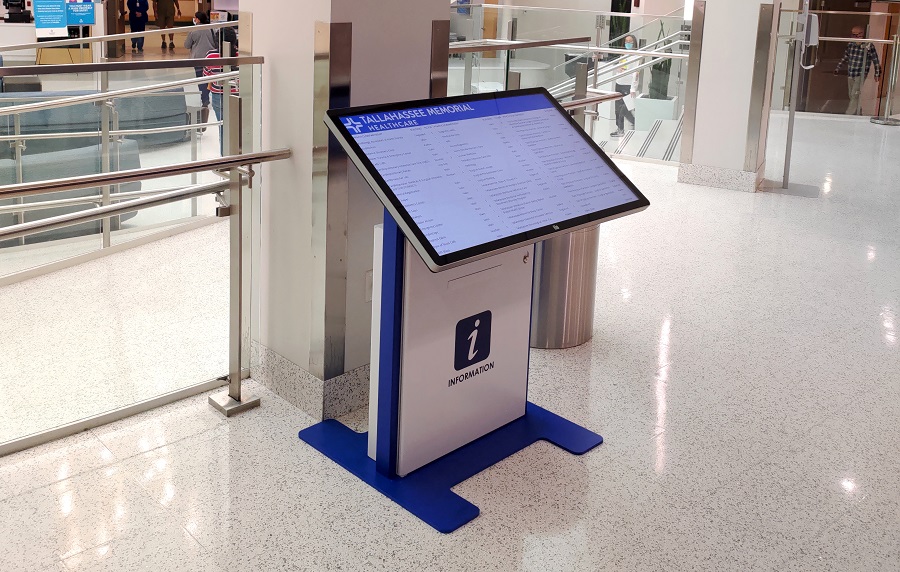Kiosks have become a common sight in many environments, and their popularity has as much to do with their utility as their versatility. Interactive kiosks can provide services as diverse as self-checkout, wayfinding, vending, ticketing and ordering. Today, we will discuss the features and benefits of self-service digital kiosks.
What is an interactive kiosk?
An interactive kiosk comprises a metal enclosure housing specialized hardware and software that allows access to information and applications related to communication, commerce, entertainment or education.

Features & Parts of an Interactive Kiosk
Every interactive kiosk includes the following components:
- Enclosure: The kiosk enclosure acts as protective housing for the display, internal hardware and software, plus specialized components such as coin and bill holders or printers. Enclosures are available in a wide variety of styles to fit just about any environment and space, whether indoors or out. Enclosures are generally constructed from high-quality stainless steel or aluminum, depending on their intended use. Most enclosures can be painted, coated, and/or wrapped in ways that allow for ample exterior branding when desired.
- Digital Display: Most interactive kiosks utilize touch screens similar to those found on modern smartphones. This allows users to easily access more information than what would be available to them on a kiosk that was manufactured with only a static, non-touch display. However, COVID-19 has increased the popularity of non-touch interactive kiosks that are accessed via the user’s personal mobile device. These allow users to access all of the kiosk’s information and functionality by simply scanning a QR code, allowing them to bypass the touch screen completely.
- Software: Kiosks are essentially computers housed in a large shell, so it stands to reason that software would be required for the computer to work. Software is what enables all of the kiosk’s functionality and capabilities. Most modern kiosks run on programs that are Cloud-based, therefore the software can be updated and maintained remotely.
- Components and Integrations: Kiosks can house components such as bill and coin collectors, ticket and receipt printers, and NFC sensors that allow them to function as payment kiosks in many different environments. Other common kiosk components include keypads, cameras, cash dispensers, infrared thermometers, digital scales, and even biometric scanners depending on the use case.
Types of Interactive Kiosks
Wayfinding
Wayfinding kiosks are designed to help users navigate an unfamiliar space, whether inside a single building or outside in a large city. This is accomplished via static and interactive maps, as well as turn-by-turn directions, which can often be “handed off” to users’ mobile devices via QR code so they can access them on the go. Wayfinding kiosks can help decrease stress and increase user satisfaction, especially in places like hospitals, college campuses, or malls.
Information
An information kiosk displays information that is stored in its database about a given subject in a clear, accessible and compelling way. Popular uses for information kiosks include museums, “smart cities,” shopping malls, and libraries.
Payments
Payment kiosks allow users to pay for goods and services. Some only allow digital payments, such as credit cards, via chip and pin or contactless NFC (near field communication) technology. Others are integrated with bill and coin collectors and dispensers so that cash may be used to pay, and change given. Most utilize printers in order to dispense receipts. Payment kiosks vary in their complexity, with some even able to accept payment and print tickets for entertainment venues, such as concerts, movies or sporting events.
Self Check-In
Self check-in kiosks allow users to access their reservations, including those for conferences, hotels, air travel, or restaurants. Some kiosks offer functionality that gives users the freedom to make adjustments to their reservations and, if necessary, pay for the changes at the same time. A self check-in kiosk can drastically reduce wait times in many environments, as it often eliminates the need for personal assistance from a customer service representative.
Advertising
Kiosks can be excellent tools for engaging potential customers via marketing and branding. As they are designed to attract attention, they can showcase a variety of advertisements that are dynamically displayed as opposed to typical static ads. These ads are easy to change out as seasons, sales, and circumstances change.
Industries That Use Interactive Kiosks
Kiosks have quickly been adopted by a multitude of different industries and businesses.

Healthcare: Interactive kiosk adoption can improve patient experience by decreasing wait times, as well as making access to services more convenient. Technologies such as self-check-in, wayfinding and on-site telehealth services all lead to greater overall patient satisfaction.
Education: Educational institutions have adopted digital kiosks to provide easier access to information and wayfinding assistance. This allows students to easily and painlessly locate their classes and any other important buildings on campus. Information kiosks keep students and staff informed of current and upcoming events, and are easily updated when circumstances change.
Retail: Retail centers such as shopping malls and big box retailers use interactive kiosks to allow customers easier access to information from the location of various items to the stores themselves. Some retailers offer users a self-checkout option as well, which can help decrease wait times, especially for those with smaller orders on busy days. Digital signage has also become popular for marketing and branding purposes.
Entertainment: Arenas, stadiums, concert and event venues, and movie theaters have all adopted ticketing and payment kiosks to allow for more self-service options, decreasing wait times for entrance as well as concessions.
Travel & Tourism: Many cities and tourist attractions utilize interactive kiosks to provide travelers with information kiosks and wayfinding solutions so that they may more easily orient themselves to their surroundings. These kiosks can also help direct tourists to relevant places such as entertainment, attractions, lodging and food. Some kiosks also accept payment and print tickets for various modes of transportation, such as trains and buses, or for entrance into attractions. Airlines were one of the first major adopters of digital kiosk technology, using it to help more customers check in without the need for assistance.
Food and Beverage: Quick-service restaurants (QSRs) were among the first to adopt kiosks in foodservice environments. These self-service kiosks are able to handle a large volume of orders within a short period of time. This allows restaurants to redistribute their staff to focus on more pressing matters such as customer service, while delivering greater order accuracy.
Advantages and Disadvantages of interactive kiosks
Advantages
- Adaptable: Digital kiosks allow business to adapt to a variety of scenarios and situations such as influx esof patients/customers or a lack of available staff.
- Reduce costs: Kiosks can lead to reduced costs when fewer staff are needed. They can also reduce human error which can lead to waste, such as incorrect food orders that need to be remade.
- Integration-friendly: Most kiosks are wifi capable, and able to be connected wirelessly to a variety of different systems via cloud technology. This allows for a wide variety of services to be integrated into one kiosk, including ordering, weather and news, accurate inventory information, check-in, check-out, wayfinding and payments.
- Increase profits: Kiosks allow for greater and more consistent up- and cross-selling opportunities that humans simply cannot match.
- Allow more efficient service: Automation creates efficiencies that are difficult to replicate with human workers. Although no machine has 100% uptime, they do not require breaks or sick days, and are nearly always available to assist with less complex tasks.
- Offer a better customer experience: Allowing visitors and customers to access information, products or services without personal assistance reduces wait times, which leads to higher levels of customer satisfaction.
Disadvantages
- Can be costly: Some kiosks require a larger initial investment than some may be willing to pay. The larger and more complex the kiosk is, the more expensive it tends to be. However, there are many kiosks -- such as those run on tablet computers -- that are quite affordable. An experienced kiosk manufacturer will be able to offer a full range of options and will be transparent about the functionality that is available at different price points.
- Limited functionality: Kiosks cannot handle complex tasks, and are intended to be used for simple, repetitive functions, such as ordering, self-payment, check-in/check-out, and small item dispensing.
- Lack of human interaction: Kiosks can offer a great way to increase efficiency in many circumstances, but their lack of humanity may be off-putting to some. It’s important that, when offering a kiosk option, that personal assistance is still available for those who prefer to talk to another person for help.
Examples of Organizations Using Interactive Kiosks
Wendy’s
REDYREF was contracted by Wendy’s Hamburgers to provide an attractive self-ordering and payment kiosk that would appeal to younger customers and provide a more customizable experience while reducing costs. REDYREF developed a new kiosk model, the Presto, to meet Wendy’s needs. The kiosk is able to be pole or wall-mounted, allowing it to be placed at key traffic areas in the store. Once deployed, the kiosk drastically improved Wendy’s profits via its ability to consistently up- and cross-sell, as well as automate tasks that had previously required employee assistance.
AT&T
AT&T contracted with REDYREF to help create a kiosk that could handle their customers’ self-payment and SIM card-dispensing needs. As a result, REDYREF designed a retail kiosk able to handle bill payment, dispense SIM cards, and provide information about various mobile phone plans without requiring direct assistance from employees.
Tallahassee Memorial Healthcare
The Tallahassee Memorial Healthcare Center required a new wayfinding solution incorporating maps, directions, hospital information, and news. REDYREF designed new digital kiosks capable of doing all of the above, plus weather updates, emergency notifications, and detailed interactive maps for each individual floor within the hospital campus. The kiosks can also be lowered to meet standard wheelchair height, making them more accessible to a wider range of users, an especially important feature within a healthcare setting.
Kansas City International Airport
REDYREF was contracted to assist the Kansas City International Airport with launching its new interactive kiosk program. The kiosks were designed with touch screens to give travelers easy access to a robust set of features, including interactive airport maps and directories, wayfinding, flight statuses and an emergency system that connects and communicates with the airport as a whole.
Interactive kiosks can benefit many different businesses and organizations. With more than 100 years of experience, REDYREF is one of the leading kiosk manufacturers in the country. They have extensive understanding of kiosk needs in industries as diverse as healthcare, retail, food service, travel and hospitality. This experience means they know what these businesses need and are able to create kiosk solutions able to directly address them. Interested in interactive kiosks? Get started with REDYREF by requesting a complimentary quote online.


